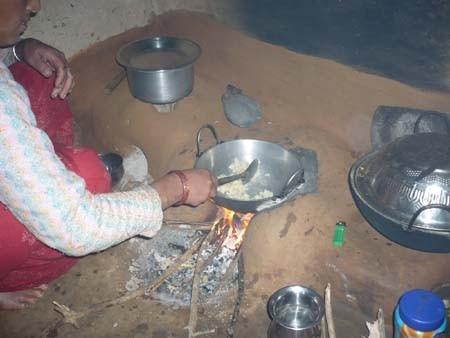Om's Food Hygiene Intervention - January 2013

What have I been up to?
In my first blog post, I gave an overview of my PhD research and mentioned that I was soon to be embarking on the second phase of the work in Nepal. So, having arrived in Nepal, I commenced the challenge of designing a simple and scalable food hygiene intervention which will allow me to measure the effects of this behaviour-change intervention on mother’s food hygiene behaviours and the level of contamination in child’s food and diarrhoeal diseases among young children.
These last two months I have been busy identifying five prioritized behaviours on which to base the design of a simple and scalable food hygiene promotion package. The behaviours were chosen after assessing the current food hygiene behaviours of mothers in my study area and their determinants, microbes in child’s food, and identifying critical and behavioural control points. The resulting food hygiene promotion package has been designed in such a way that it will help to motivate mothers to practices and habituate the following prioritised behaviours:
- Thorough cooking of child’s food (identified as critical control point but not prioritized as many mothers currently practicing)
- Cleaning of serving utensils using ash or soap before putting cooked/re-heated food into serving utensils
- Handwashing with soap before feeding (mother) and eating (child)
- Store cooked or leftover food in container with a tight fitting lid to protect from flies, dust and dirt
- Thorough re-heating of leftover or stored food
- Boil milk and water before serving
Getting creative
I then produced a comprehensive creative brief which highlighted prevalent behaviours, social, physical and environmental barriers, and motivational factors for each of the above six food hygiene behaviours. As I had previously planned in research protocol, a creative team was formed with members from different expertise and professional exposure and experiences of designing and developing a behaviour change and communication package. After receiving a detailed presentation on the prioritized behaviours and creative briefing regarding developing a simple and scalable food hygiene promotional package, the creative team visited study area to allow them to better understand the context, feasibility, setting and socio-cultural aspects.
With the support received from the creative team, I have developed a food hygiene promotion package that will be easy to replicate in a wider community. While designing the intervention, emphasis was placed on community mobilization, interpersonal communication and print media.
What will the promotion package entail?
The food hygiene promotion package includes various innovative tools and techniques which will motivate mothers to improve the aforementioned six key food hygiene behaviours. Such tools include storytelling, video clips, flex, folk songs / ring tones, ‘ideal mother’ concept, walkathon, public appeals, use of glo-germs, ‘beeps’, ‘teach the friends’ session, flip charts, clean kitchen competitions and demonstrations, puzzle games, household observation, role model exercises, folk song competitions, musical chair games, declaration of ‘ideal mothers’, ‘ideal mothers’ posters and photos in the village, watchdog exercise (peer review exercise), public pledging, declaration of safe food hygiene zone, distribution of appreciation certificates and so on.
How will it be delivered?
The whole food hygiene promotion package will be delivered within three months through six community events and six household visits by 15 locally recruited ‘food hygiene promoters’ in four intervention clusters. A five day training session will be provided to all food hygiene promoters to improve their technical knowledge on the subject and develop their skills in conducting community and household-level events using the package.
To make local stakeholders accountable in this intervention study from inception, the project coordination committee has been formed under the chairmanship of village development committee secretary with representatives from local health institutions, local social leaders as well as myself in both the village development committees. The Child Health Division and the Ministry of Health and Population (a local collaborator) have already circulated a letter to the respective district to ensure collaborative support of the intervention study through their local health institutions.
What's next?
Dr Val Curtis, Director of the Hygiene Centre at LSHTM and my PhD supervisor, is joining us in late January 2013 to provide her expert inputs on the overall intervention package to help facilitate and finalize the intervention. I’m looking forward to warmly welcoming Dr Val to Nepal. As soon as the prototype intervention package is finalised, it will be piloted in its entirety before it is then finalised and implemented in four intervention clusters. The baseline of the study will be conducted in March 2013 to set a benchmark to compare the effects of the intervention through a follow-up study after intervention is implemented.
In my next blog, I will write more on intervention package finalisation process, update on Dr Val’s visit to Nepal, the baseline study, cluster randomisation and recruitment.
